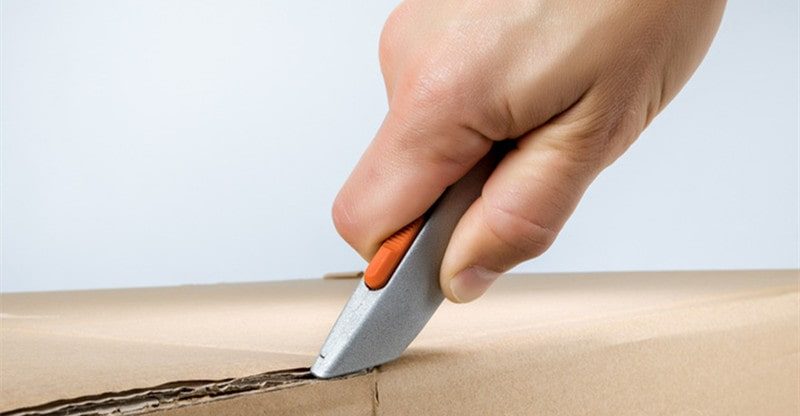What Qualities Should You Look For When Choosing A Safety Knife?
When you hear the word safety knife, you may automatically think that the knife is safe. But don’t let that label fool you. A knife may seem to be high-end with all the latest features only to be ineffective when cutting. When choosing a safety knife, it’s necessary to do research to find quality, reliable safety knives. Not all safety knives are alike.
Here are some tips on what to look for when choosing a safety knife.
Considerations for Selecting a Safety Knife
Start with: What will the knife be used for? What type of material will you be cutting?, and How thick is the material you’ll be cutting? Material thickness determines the length of blade exposure needed.
Another consideration is how often you’ll be cutting. Safety knives are used in many types of industries, but not all of them are heavy users. Shipping and receiving, warehouse facilities, manufacturing, factories, and distribution centers are just a few environments where you will find heavy safety knife usage.
These industries often use safety knives for cutting things like heavy cardboard, containers, boxes and cartons.
Blade Safety and Ergonomics
Blade safety and ergonomics are two of the most important aspects of a safety knife. Here are some of the things to look for:
Blade Safety
The main component of a safety knife is the blade, but all blades on a safety knife are not created equal. A blade can be too sharp or too dull; both situations are dangerous. Blades are constructed using different materials. Zirconium oxide blades are chemically inert, meaning they don’t rust.
These blades are also much harder than steel blades and don’t need to be as sharp because they last longer. Most manufacturers make them just as sharp as metal blades, though, so do your research and look for a safety edge before you buy.
You should be able to touch a blade without fear of piercing your finger. Of course, running your finger across blades should not be a common practice, but there will be times when you may need to have contact with the blade. Look for blades that use a grinding process at two different angles.This creates an effective cutting edge that does not pose danger to the user.
Ergonomics
You might not expect ergonomics to be part of safety knife quality, but it’s important when searching for an effective safety knife. In recent years, manufacturers have not just focused on blade safety, but on comfort when using safety knives.
Not only is ergonomics important for comfort, but it helps reduce risk of injury by reducing strain on muscles, which reduces the chance of accidents, and therefore prevents lacerations.
Repetitive strain injuries (RSIs) are common in the workplace. This can be a result of the way the knife handle is designed. Look for handles that will help reduce the strain on wrist, arm, and hand muscles, and that fit comfortably into the hand.
Kyle Ver Steeg, plastic surgeon and outdoorsman who has years of experience with knives, provides his perspective on ergonomics and knives. When asked about knife handles that are not designed for ergonomics he says, “You’re going to be able to do less work with it, and at the end of that work you’re going to be more tired.”
Increased strain also makes you more prone to accidents and slip-ups. He points out that sharp angled handles with squared-off pieces conflict with the naturally curved dimensions of the hand.
Manufacturers are using new technologies and innovative designs to produce well-designed, safer, more effective safety knives.Trigger mechanisms that are easier to use, sliders that pull instead of push, and no-touch blade changes are just a few examples of improvements that will benefit you.
Three Most Common Safety Knives
Safety knives come in many brands, forms, shapes and sizes. Here are three of the most common you’ll find on the market.
Auto-retractable – The auto-retractable knife is made with a spring that retracts the blade into its housing. It includes a slider that can be controlled by keeping your thumb on the slider so that it will not retract until you remove your thumb. This keeps the blade exposed for as long as you want.
Concealed blade – This blade is exposed at all times but remains hidden in a cutting channel. The user is never exposed to the blade, so the knife is safe even when not being used for cutting.
Smart Retracting – This blade is similar to the auto-retracting type, except it cannot be controlled by keeping your thumb on the slider. The blade will retract automatically when it reaches the end of the material whether the thumb stays on the slider or not. This lessens the possibility of injury due to human error.
The Quality of Your Questions
The quality of your safety knife will be determined by the questions that you ask during your research. Ask questions like:
- Is the knife ergonomically designed?
- How is the blade designed?
- What material is the blade made from?
- What makes one knife safer than another?
Gathering thorough information can save you time and money that might otherwise be spent on serious injuries. Whichever safety knife you decide on, there is one more crucial component that you should not leave out—training. Even the safest knife requires instruction on proper handling.



